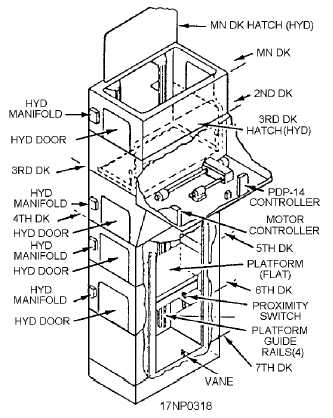switch to shutoff the power to the hoist motor and
electric brake. Loss of electric power causes the brake
to automatically stop the elevator. If the brake fails to
stop the elevator, the governor sheave grips the
governor rope, causing the broken-rope safety device to
stop the elevator.
A slack, cable sensing, safety device is provided for
each suspension rope and the governor rope. Located in
the area between the winch drums and the overhead
sheaves,
these
devices
function
by
applying
a
spring-loaded follower roller to the wire rope. Rope
slack causes a proximity switch to shutoff electrical
power to the hoisting winch motor and brake, which
stops the elevator.
If the elevator over travels upward beyond the
maximum up stop position, an over travel limit switch
is actuated. This stops the elevator by shutting off
power to the hoisting winch motor and brake.
If the elevator over travels downward beyond the
hold deck loading station level, spring bumpers in the
bottom of the elevator trunk stop the platform. The
slack-cable switches are actuated to cut off power to the
hoisting winch motor and brake.
An operator-attended control panel is located next
to all elevator doors. All operator control panels have a
display of selector switches, push buttons, and indicator
lamps suited for the control functions required at the
station served. All control panels have an emergency
stop-run switch from which all operations of the
elevator can be stopped.
The main operator control panel and electrical
power switch are located at the 2nd deck-level station.
An elevator can be dispatched to another level from any
operator control panel. The lower-stage elevator control
system can dispatch the elevator to another level.
However, it can't retrieve the elevator from another
level.
IMPROVED WEAPONS HANDLING SYS-
TEM
(IWHS)
LOWER-STAGE
WEAPONS
ELEVATORS.—The IWHS lower-stage weapons
elevator
(fig.
11-11)
services
magazines
and
ammunition handling areas from the 7th deck level up
to and including the main deck (hangar deck). The
IWHS is a highly sophisticated system controlled by a
PDP-14 programmable controller that continually
tracks the location of the platform to within one-twelfth
of an inch. Because of the complexity of the IWHS,
elevator operators and maintenance personnel are
extensively trained in hydraulics, electricity, and
electronics.
Four cables attached at the corners lift the platform.
The platform machinery is located at the 3rd deck level.
The hatches are opened hydraulically. They are
designed
to
automatically
undog-open-latch
and
unlatch-close-dog. The elevator doors are also operated
hydraulically.
The IWHS incorporates the following safety
features:
An over speed governor slack-cable device
An over speed governor device
A hydraulic interlock to prevent two hatches
from being opened at the same time
A hydraulic interlock to prevent hatches from
closing when dogs are in the dogged position
An electrical interlock to prevent opening a
magazine door unless the platform is at that level
An electrical interlock to prevent opening more
than one magazine door at a time
A pressure switch to prevent operation of the
elevator when the hydraulic pressure is below
1,200 psi
11-19
Figure 11-11.—Typical IWHS lower-stage, weapons elevator.

